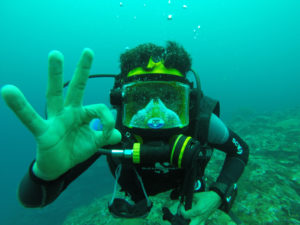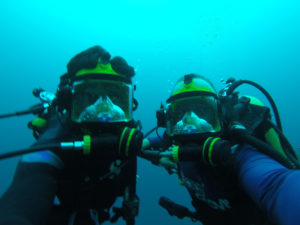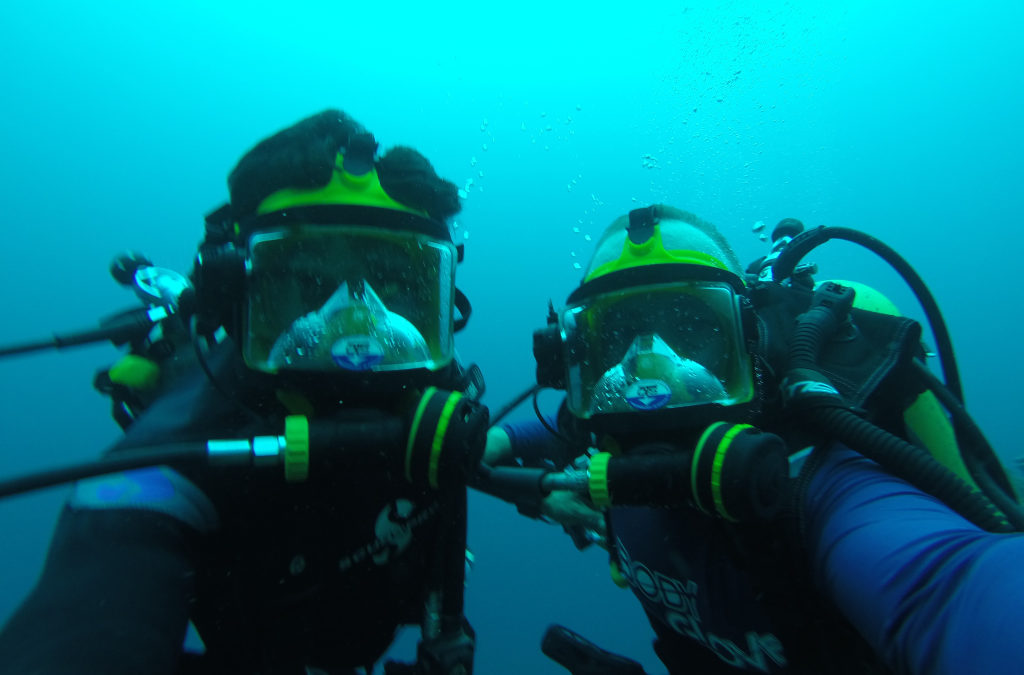Para bucear no hace falta vista de lince; es algo que puede hacer cualquiera que sepa nadar y tenga una salud normal.
Tener miopía o cualquier otra alteración de la visión como astigmatismo que nos obligue a llevar corrección en nuestra vida cotidiana, ya sean gafas o lentillas, no es por sí incompatible con la actividad de buceo, por supuesto salvo que el médico nos indique lo contrario.
De hecho es muy habitual bucear y llevar gafas o lentillas en superficie. En el supuesto de miopía o mala visión de lejos, si ésta es muy moderada -pongamos que por debajo de -1 dioptría- muchos buceadores dicen que no necesitan ninguna corrección para cuando se sumergen y que al ver a través de la máscara milagrosamente parece corregirse su pequeña tara. Esto es así por la refracción de la luz al pasar del medio líquido al aéreo de la máscara, y que tiene como consecuencia bien conocida por todos los buceadores, que los objetos se vean de un tamaño y proximidad aparente mayor a la real, es decir, 1/3 más grandes y ¼ más cerca. Estos privilegiados miopes tiene el problema solucionado.

buceo full face miopia
Los demás, los que no tenemos suficiente con la corrección automática de la refracción para ver bien tenemos que acudir a algún otro apaño si no queremos perdernos parte de la riqueza y detalles de los fondos marinos. Aquí caben dos soluciones, una, la de usar lentillas, y la otra, llevar corrección en las gafas de bucear.
En el caso de las lentillas, lo habitual para no correr demasiados riesgos es usarlas de esas desechables, de las de uso diario, que vienen a costar sobre un euro. Gozaremos de una buena visión y salvo que nos entré continuamente agua en la máscara no tenemos que preocuparnos en evitar que la lentilla se pierda. Hay incluso quien dice que ha abierto los ojos con ellas puestas y sin máscara y no las ha perdido. Pero mejor no correr riesgos y por si acaso, como os digo, optar por las desechables y no por las mucho más caras de uso mensual o aún mayor.
Si optamos por hacer la corrección en la máscara también tenemos dos opciones, la de comprar unas gafas de bucear que dispongan de cristales graduados, generalmente en intervalos de 0,50 dioptrías, y no olvidarnos nunca de ellas, siendo el primer objeto que pongamos en la bolsa , no vaya a ser que la anhelada escapada de buceo devenga en pesadilla borrosa, o bien adquirir unas gafas que, llevando los cristales normales, permiten que exteriormente se le adapten otros complementarios con la corrección visual. Yo personalmente utilizo las primeras, éstas no las he probado aún pero cualquier día me compro unas y os cuento.



full face miopia diver
You don’t need a lynx sight to dive; It is something that anyone who can swim and has normal health can do.
Having myopia or any other vision impairment such as astigmatism that forces us to correct our daily life, be they glasses or contact lenses, is not inherently incompatible with diving activity, of course unless the doctor tells us otherwise.
In fact it is very common to dive and wear glasses or contact lenses on the surface. In the case of myopia or poor vision from afar, if this is very moderate – say below -1 diopter – many divers say they do not need any correction for when they dive and that when they see through the mask miraculously seems to correct Your little tare This is because of the refraction of the light when passing from the liquid to the aerial medium of the mask, and that has as a consequence well known by all divers, that the objects are of an apparent size and proximity greater than the real one, that is to say , 1/3 larger and ¼ closer. These privileged nearsighted people have the problem solved.



buceo full face miopia
The others, those who do not have enough with the automatic correction of the refraction to see well we have to go to some other device if we do not want to miss part of the wealth and details of the seabed. Here there are two solutions, one, to wear contact lenses, and the other, to correct the diving goggles.
In the case of contact lenses, the usual thing not to take too many risks is to use them for those disposables, for those of daily use, which come to cost over one euro. We will enjoy good vision and unless we continually enter water in the mask we do not have to worry about preventing the lens from getting lost. There are even those who say that they have opened their eyes with them on and without a mask and have not lost them. But better not to take risks and just in case, as I say, opt for disposables and not for the much more expensive monthly or even higher use.
If we choose to make the correction in the mask we also have two options, to buy some diving glasses that have graduated glasses, usually in intervals of 0.50 diopters, and never forget them, being the first object that we put in the bag, it is not going to be that the desired diving getaway becomes a blurred nightmare, or to acquire glasses that, wearing normal glasses, allow externally to adapt other complementary with the visual correction. I personally use the first ones, I have not tried them yet but any day I buy some and tell you.



full face miopia diver


SM
I have been checking out many of your stories and it’s clever stuff. I will surely bookmark your blog.
I haven’t checked in here for some time since I thought it was getting boring, but the last few posts are good quality so I guess I’ll add you back to my everyday bloglist. You deserve it my friend 🙂
+1
Thank you; from every person of us. Shelley Avigdor Lib
great post +1
Sile Gilberto Darsey
Definitely, what a great blog and enlightening posts, I surely will bookmark your blog. All the Best! Clovis Haze Morly
I was curious if you ever considered changing the page layout of your website? Lyssa Edsel Gudrun
I really like it when individuals come together and share thoughts. Great website, stick with it! Kellen Berk Seta
Very interesting information!Perfect just what I was searching for! Jannel Dan Kingdon
amazing
fantastic